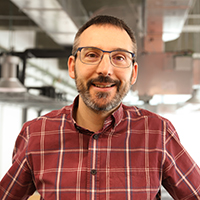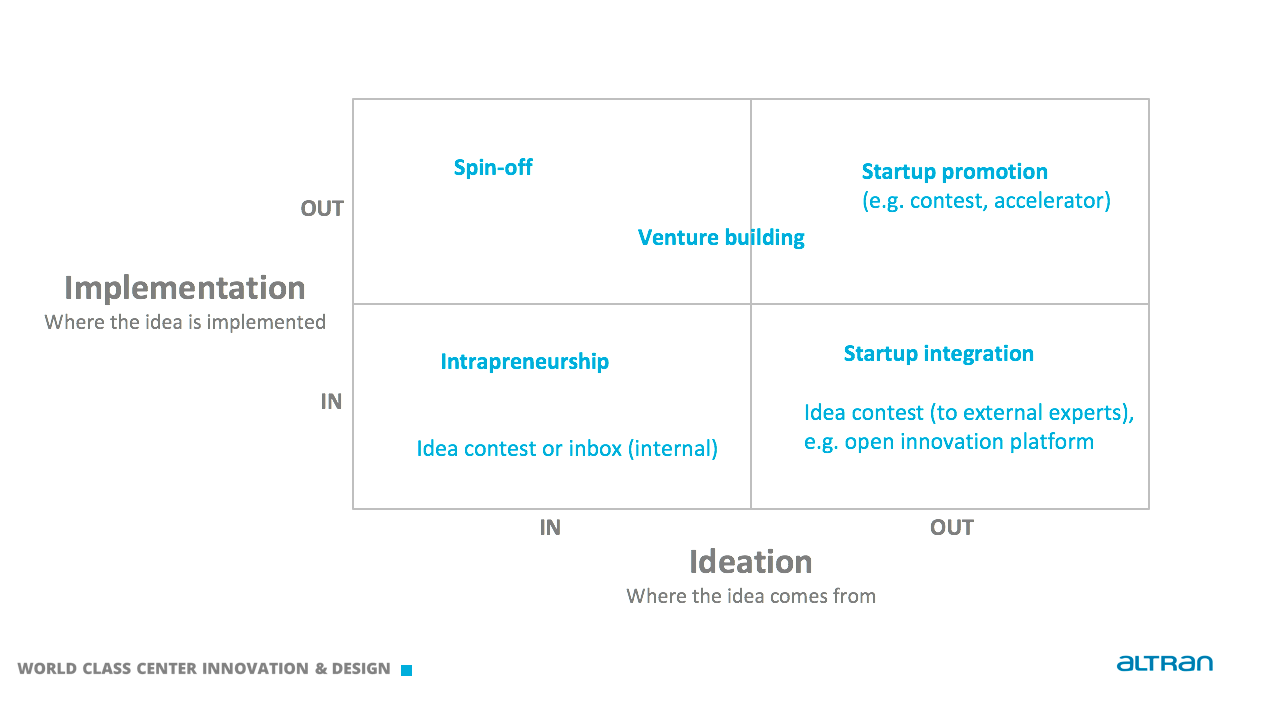Daniel Almodovar leads the business validation practice at World Class Center Innovation and Design. There, his process includes documenting the initial business idea, extracting and prioritizing hypotheses, validating problem, solution, market demand, profitability, measuring, learning and adjusting the solution. Depending on the client’s interest, they can provide training, mentorship or externalization of the validation.
In this exclusive interview, we talk about why companies need to innovate (and can’t just buy startups):
Etienne Garbugli (EG): Could you tell us about your work at World Class Center Innovation and Design?
Daniel Almodovar (DA): We are part of Altran, a leading firm in engineering and R&D. Within the company, we represent the global team for innovation and design, addressing projects that cover the whole lifecycle of innovation: trends & technology radar, customer insights, creative problem-solving, invention, prototyping, business validation, UX/UI design, and product realization up to manufacturing of small series. We also have transformation programs for organizations to boost their innovation potential. Our clients are medium and large corporates from all industries, with national and multinational footprints.
I participate in projects of nearly all the practices. I particularly enjoy cases in which we run an invention project that generates new promising concepts and then we continue working in their business validation, moving them towards reality.

EG: How did you get into the innovation space initially?
DA: I had been part of the Vodafone Group R&D team for many years and, there I had not only executed many innovation projects but also tried different innovation methodologies, to the extent that I became an internal consultant. It was a natural transition for me to move to Altran’s innovation team.
What I like the most in this career change is the opportunity to live innovation in so many different sectors: finance, insurance, chemical, industrial, energy, automotive, aerospace, urban services, consumer goods… This helps you realize that innovation shares common issues everywhere.
EG: What are some of the methodologies you use in your work?
DA: I mainly use the Lean Startup framework, Business Model Canvas, some Design Thinking tools, and a methodology called Synectics, which provides a strong basis for successful human interaction in creativity and problem-solving.
Rather than being tied to a single methodology, I believe that what works is to have a varied toolkit from which you select the right tools for every project and client need. For instance, sometimes I have also used the Jobs-to-be-Done framework, Google Design Sprint, or the Innovation Games set.
EG: What are some of your best practices when it comes to innovation?
DA: Innovation is carried out by people. For me, the ideal innovation project is when the people that participate in the project live a personal transformation and acquire a new mindset that can apply from that moment on in their future projects – and even in their lives. This happens, for example, when they get to experience the benefits of understanding their customers, releasing their creative thinking or validating the critical assumptions behind what they want to build.
In the same way, it’s essential for people to understand purpose. Why are we doing this innovation project? Why are we using this tool or doing this activity? How will all this contribute to a goal? The innovation facilitator must always make sure it is clear for all participants.
The facilitator also has to explain the differences, in terms of mindsets and rules, between the operational world and the innovation world. This prevents the premature killing of promising concepts because they’re applying the operational mindset. The key is to manage the transfer from the innovation space to the operational space.
EG: How important is innovation and innovation management to organizations today?
DA: What comes to mind may sound very cliché: the “VUCA” environment, the increased frequency of disruption in every sector, the decrease in companies’ lifespans… You simply cannot afford to ignore innovation. And at the same time, you must operate your core business, what currently brings in the money. I agree with most innovation thinkers that carrying out innovation and operation in parallel is the biggest challenge that companies have to overcome nowadays.
EG: How do you see it evolve over the next 5, 10 or 15 years?
DA: I think that, during the next years, we will see a gradual process in which organizations will learn from success cases and will get better in being “ambidextrous”, executing their core business and exploring new businesses at the same time – with effective transfer from the second activity to the first.
In addition, I’m also very curious about the evolution of internal vs. external innovation, i.e. on the one hand, internal innovation projects or intrapreneurship; on the other hand, open innovation challenges or engagements with startups (which is so popular today and for some companies seem to replace internal innovation). I think that both have pros and cons and that the right approach is a mix. Actually, the binary division internal vs. external is quite simplistic, and changes when you start including other dimensions such as ideation and implementation (see model below).
EG: What are the main challenges faced by innovation experts in the industry today?
DA: If I wanted to make a joke based on what I have experimented frequently, I would say that the fact that nearly every company applies a reorg every 6-9 months! This changes the points of contact for innovation and/or freezes innovation projects due to re-prioritization of activities.
More seriously, the answer would be related to the previous questions, i.e. companies applying only the operational mindset or taking care exclusively of short-term results and fast return on investment – indeed, the most common complaints I hear from participants in innovation projects are “I don’t have time for this as I’m very busy with the daily operations” or “This activity is not in my objectives”.
Another challenge would be companies thinking that they don’t need any innovation system or process and that they just have to “wait and buy” the innovation that happens externally.
EG: What do you feel are the challenges of innovators operating in a B2B environment?
DA: Many challenges are common to the overall innovation space. However, you must be very aware of the specifics of B2B, such as the fact that you have “fewer shots”, or that you have different client-people within the same client-company requiring different value propositions or that experimentation must coexist and not disturb the ongoing business. All this is very well explained in the Lean B2B book. 🙂
EG: What value did you get from reading Lean B2B?
DA: It was really helpful for me. I had read most of the Lean Startup literature (Eric Ries, Steve Blank, Ash Maurya, Cindy Alvarez, etc.), but I was missing a comprehensive explanation of the specifics for the B2B space. In Lean B2B, I found confirmation of many of my previous thoughts or intuitions about applying Lean Startup in B2B, as well as many new clarifying and useful ideas. It is really well structured both in the overall chapter distribution/narrative and in the checklists, tables, sidebars, tips that every chapter includes. I bought the paperback edition and it is now full of pencil marks and underlines, pointing to pieces of knowledge that I have used in my projects.
If I had to choose one powerful idea I extracted from the book and soon internalized, it would be the fact that Lean Startup in B2B is strongly linked to strategic selling and must consist of building a trust relationship. Many other concepts or pieces of material in the book have become part of my personal toolkit, such as the “jury”, the “money map”, “Value = Benefits-Costs”, the interview templates, or the tips for first pilots, case studies and discounts.
EG: How have you been using the ideas from the book?
DA: When I got the book I was actually running a project consisting in mentoring a client’s team through a Lean Startup process in the B2B space, so it was a great help to reinforce the B2B specifics beyond the general Lean Startup framework. Afterwards, I have used the toolkit I obtained from the book when running any project or initiative that involves B2B. This refers not only to projects with external clients but also with internal clients (e.g. to help Altran R&D projects go to market) or within our own innovation team (e.g. to expose our new innovative offerings to our customers).
EG: What innovation advice would you give to organizations operating in competitive industries today?
DA: I would advise not to let innovation happen just as a spontaneous activity that depends on the personal initiative of a few employees; instead, start creating and nurturing an “innovation system” like the Innovation Model Canvas, something that continuously fuels the company with ideas for new businesses and validates them so that they can become a reality.
EG: Thank you for your time.
DA: Thank you.
Download the First 4 Chapters Free
Learn the major differences between B2B and B2C customer development, how to think about business ideas, and how to assess a venture’s risk in this 70-page sampler.
Working on a B2B Startup?
Learn B2B customer development with our free email course:




